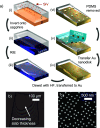Plasmonic Diamond Membranes for Ultrafast Silicon Vacancy Emission
- PMID: 38478720
- PMCID: PMC10979444
- DOI: 10.1021/acs.nanolett.3c04002
Plasmonic Diamond Membranes for Ultrafast Silicon Vacancy Emission
Abstract
Silicon vacancy centers (SiVs) in diamond have emerged as a promising platform for quantum sciences due to their excellent photostability, minimal spectral diffusion, and substantial zero-phonon line emission. However, enhancing their slow nanosecond excited-state lifetime by coupling to optical cavities remains an outstanding challenge, as current demonstrations are limited to ∼10-fold. Here, we couple negatively charged SiVs to sub-diffraction-limited plasmonic cavities and achieve an instrument-limited ≤8 ps lifetime, corresponding to a 135-fold spontaneous emission rate enhancement and a 19-fold photoluminescence enhancement. Nanoparticles are printed on ultrathin diamond membranes on gold films which create arrays of plasmonic nanogap cavities with ultrasmall volumes. SiVs implanted at 5 and 10 nm depths are examined to elucidate surface effects on their lifetime and brightness. The interplay between cavity, implantation depth, and ultrathin diamond membranes provides insights into generating ultrafast, bright SiV emission for next-generation diamond devices.
Keywords: Purcell enhancement; diamond; nanocavity; plasmonics; silicon vacancy.
Conflict of interest statement
The authors declare no competing financial interest.
Figures




References
-
- Somaschi N.; Giesz V.; De Santis L.; Loredo J. C.; Almeida M. P.; Hornecker G.; Portalupi S. L.; Grange T.; Antón C.; Demory J.; Gómez C.; Sagnes I.; Lanzillotti-Kimura N. D.; Lemaítre A.; Auffeves A.; White A. G.; Lanco L.; Senellart P. Near-Optimal Single-Photon Sources in the Solid State. Nat. Photonics 2016, 10 (5), 340–345. 10.1038/nphoton.2016.23. - DOI
LinkOut - more resources
Full Text Sources

